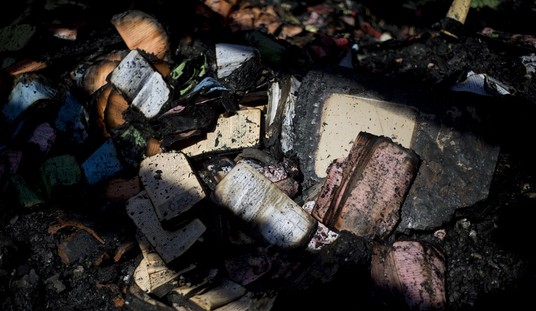I don’t know if I’d go quite that far, but can you figure out what this is supposed to represent relating to Dwight D. Eisenhower?
I swear those two trees in front look like Ents, the talking trees from Lord of the Rings.
Needless to say, no one is happy; not Ike’s family, not Congress, and certainly not California Republican Congressman Tom McClintock:
“I want to know how we came up with this monstrosity,” said Representative Tom McClintock, Republican of California.
Representative Rob Bishop, a Republican from Utah, has introduced legislation calling for a new design competition and the elimination of nearly $100 million in financing to complete the memorial. The Dwight D. Eisenhower Memorial, honoring that five-star World War II general and 34th president, would be at the base of Capitol Hill, near the National Air and Space Museum.
“We need a new set of eyes to look at the situation to clearly review where the money has been spent and where the money will be spent in the future,” Mr. Bishop said at the hearing. “Our goal should be to do what is right by President Eisenhower and to do it the right way.”
When Mr. Gehry’s design was selected in 2010, groundbreaking was planned for August 2012. But the schedule has been repeatedly delayed while the Eisenhower Memorial Commission, which is overseeing the project, has confronted the design’s detractors. Mr. Gehry’s original concept called for a four-acre site partly enclosed by transparent woven metal tapestries displaying images of the Kansas plains, where Eisenhower grew up. The most controversial element was a statue of the young Eisenhower sitting on a low stone wall, a characterization inspired by a photograph of him at that age and by a homecoming speech he made after the war in which he recalled his days as a “barefoot boy.”
Members of the Eisenhower family and others objected to the memorial as an inadequate representation of the former president’s significant achievements.
So what’s wrong with it?
Justin Shubow, the president and chairman of the National Civic Art Society, who spoke on Tuesday, called the design “not salvageable.”
“What then are the universal requirements of a monument?” Mr. Shubow asked at the hearing. “Monuments are civic art that cause us to solemnly reflect on who we are and what we value. They are heroic-sized, timeless and possess grandeur. They present an ideal we aspire to rather than warts-and-all reality.”
And that’s about the best description of public art I’ve ever heard. Rare to hear anyone in the arts today talk about “grandeur.” With so much of our public art — including monuments — from the minimalist school, it’s refreshing to hear an important voice cry out for art that is dramatic and inspiring.
There’s been a ton of money wasted on the monument already. Ike — an extremely prudent man with the public purse — is no doubt doing back flips in his grave over the expansive cost of the project. There is also a more fundamental question; Does Dwight Eisenhower deserve a monument on the hallowed ground of the Washington Mall? Does he belong in the company of Washington, Jefferson, Lincoln, and King?
Eisenhower was an able commander, a first class organizer, a solid diplomat, and a much underestimated president. But outside of the Interstate Highway system and the vital step of making the space agency a civilian enterprise, there really isn’t much that he proposed that is still with us. His civil rights initiatives were noble for the time, but superseded by the Civil Rights Act. His administration created the Defense Advanced Research Projects Agency (DARPA) that eventually led to big breakthroughs like the internet. But Eisenhower never envisioned the scope of DARPA’s mission being so broad.
The fact is, Eisenhower didn’t have to do much. The booming 50’s were the result of a happy set of circumstances, not the least of which was that the rest of the industrialized world was barely on its feet as a result of being bombed nearly back to the stone age during World War II. The US made everything — TV’s, washing machines, refrigerators, and of course cars, machine tools, steel, rubber, and on and on. And we sold everything as fast as it came off the assembly line both to our burgeoning middle class in America and a Europe hungry for consumer goods.
Eisenhower was smart enough not to do anything to interfere with this economic juggernaut. And while biographers like Steven Ambrose give him credit for “creating” suburbia by pushing for the Interstate Highway system, Eisenhower’s gift to America is that he was perhaps the last truly prudent and cautious man to hold the presidency. He didn’t take chances. He didn’t rock the boat. When forced into action by sending troops into Little Rock to enforce a federal desegregation decree, he did so with great reluctance.
I think Eisenhower will be remembered as a good president, but worthy of being honored with a memorial on the Mall? I suppose if you add his outstanding service as Supreme Allied Commander during World War II, this would place him in rare company, indeed. He was one of the most consequential men of the 20th century. For that reason, a monument may be in order.
But this design? I think they can do better — and do it for less money.











Join the conversation as a VIP Member